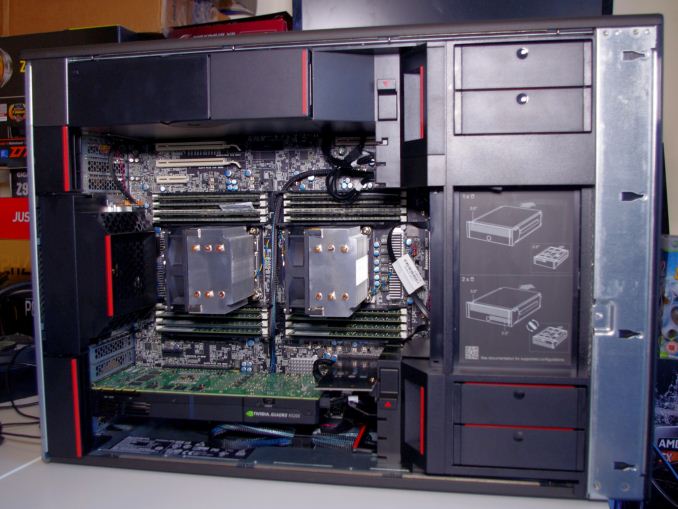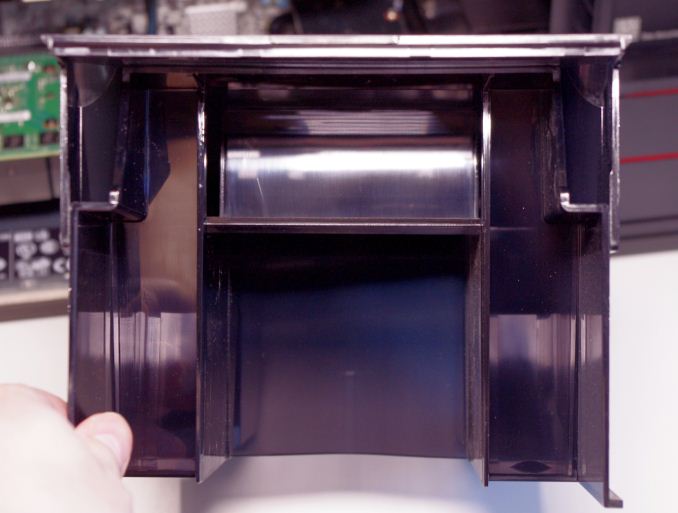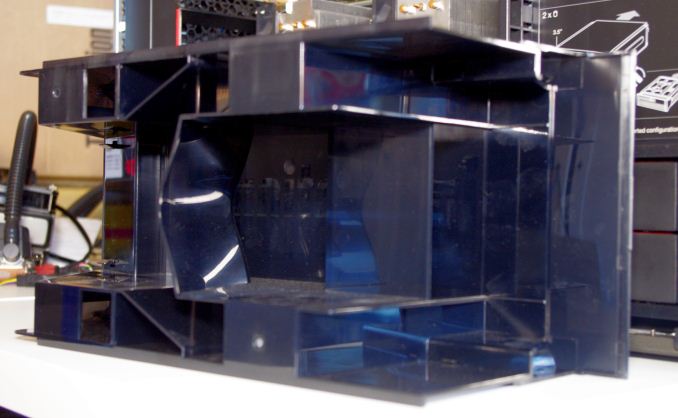The Lenovo ThinkStation P900 Workstation Review: Design 101
by Ian Cutress on May 6, 2015 7:00 AM ESTLenovo ThinkStation P900 Conclusion
As I mentioned in the introduction to the review, Lenovo is at an advantage here due to the fact that the P900 is the first high end workstation we've had in for review in quite a while. As a result it is difficult to compare the experience with the other major workstation OEMs and easy to get carried away in the positive aspects. In order to address the balance, both Dell and SuperMicro are in the process or organizing systems for us.
Despite this, Lenovo's design is pretty well done and kudos are deserved to the engineering and design teams around the P900 series. One of the key elements in workstation chassis design is the ability for system administrators to update and replace components to minimize downtime. Lenovo's design ensures that almost everything is easily replaceable, especially when it comes to drives, storage, power supplies and fans. In an attempt to minimize cabling, storage is provided either via the FLEX system or integrated into a backplane that supports both data and power. The drives for the backplane work with two drives apiece, allowing for 8 drives on the backplane and a further four PCIe devices on the FLEX connectors.
Perhaps we could point a finger and say that the PCIe devices are slightly harder to adjust, requiring a screwdriver at a minimum, but the system splits the PCIe lanes from both the processors allowing as much bandwidth as possible should multiple coprocessors be required. In order to facilitate these devices, the design also includes direct airflow through three regions - at the top and bottom the air is blown through the front, over the storage drives and through the PCIe devices then out the back. For the two CPUs in the middle, air is taken in the back and split by an air baffle into two. Each air stream then passes over an individual CPU, and the air is then directed around the ODDs and then out of the front of the case. Due to Lenovo's design, this all happens due to the arrangement of the hardware and at a relatively quiet volume. When you start enabling the power viruses the fans do kick in at a rate, but nothing unexpected for a workstation.
Performance wise, we have to grin and bear that some of our performance metrics are not particularly suited to dual processor designs. Thus despite the high end system provided with two 160W ten-core processors, sometimes for regular workloads a single processor performed noticeably faster. It even affected our SPECviewPerf numbers, despite having the better Quadro than our P300 review. That being said, I always recommend that users looking into dual processor systems know their workloads and memory requirements. If you have the software to take advantage, it always makes sense, and in our performance numbers that could take advantage of this we saw large gains over a single socket implementation especially when large amounts of DRAM are required.
One critical juncture that will be noted is the price of the unit we were sent for review. At over $16700 for a web store purchased unit, it seems at least +50% more expensive than a self-build. We saw this in our P300 review as well, to which Lenovo explained that web sales account for single digits in percentage of sales and most customers are direct b2b or to resellers that outfit with their own hardware. The prices online, Lenovo has stated, means that they are not in direct competition with their resellers and b2b customers are directed to the regional representatives for pricing.
Thus despite the cost, the P900 is designed to be Lenovo's halo workstation product in a sea of potential contenders. From a purely design point of view, I loved poking and prodding with the chassis to see how everything connected and what went where. Whatever the end user might think, the sysadmin should find upgrading and replacing components easy.













61 Comments
View All Comments
extide - Wednesday, May 6, 2015 - link
There are plenty of apps that benefit from 2P, are you just being ignorant?Refuge - Wednesday, May 6, 2015 - link
Don't like the fan connectors, it is all too proprietary, this would be an I.T. Dept. worst nightmare in the long run, expensive to purchase, and short lived.Lenovo should know better...
GTVic - Wednesday, May 6, 2015 - link
That is one connector of 3 and I'd assume the connector shown is an adapter and the fan has a regular connector that plugs into the grey adapter.Ammaross - Wednesday, May 6, 2015 - link
Anyone else notice that the images on page 1 say "Embargoed until August 12th"?Ammaross - Wednesday, May 6, 2015 - link
2013 copyright. Nevermind. :PDiHydro - Wednesday, May 6, 2015 - link
311 watts at the wall with a 1.3 kW PSU? Good thing that PSU is 90% efficient at 20% load! The whole system only has a TDP of 470 Watts. While I understand they want more power available for HDDs and add in GPUs, the PSU seems over spec'd. How was this system loaded?der - Wednesday, May 6, 2015 - link
What a station this is! Haha!ectoplasmosis - Wednesday, May 6, 2015 - link
At the risk of sounding like a cliche, Apple did a better job of the whole baffled, segmented cooling, modular industrial engineering with the Power Mac G5 all of twelve years ago.Plus their casing still looks and feels sexy today, unlike this monstrosity full of ill-fitting moulded plastic...
Even SGI boxes of 20 year vintage had more aesthetic mystique to them.
GTVic - Wednesday, May 6, 2015 - link
It is designed to move the air, who cares what it looks like. This isn't a gaming machine with plexiglass panels and mood lighting.Zak - Wednesday, May 6, 2015 - link
Can we please get better quality photos in these reviews? Please?